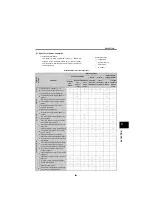
507
SELECTION
S
E
LECTION
3
3.4.5
Power supply voltage variation
The permissible voltage variation range should be within
the range from +10% to -15% of the rated voltage. If the
power supply voltage rises sharply, the semiconductor
devices and electrolytic capacitor may be damaged,
adversely affecting the control transformer, magnetic
contactor for shorting the inrush current preventing resistor,
and the like. In addition, the regenerative brake capability
will be reduced, more often resulting in regenerative
overvoltage (OV1 to 3).
On the contrary, if the voltage is reduced greatly,
undervoltage protection (UVT) or undervoltage warning
(UV) is activated and operation may not be performed
properly. Particularly when the power supply is shared
between the inverter and a large-capacity motor requiring a
long starting time, the power supply voltage may drop
sharply at when starting the motor. For more information on
power supply undervoltage, refer to page 111.
3.4.6
Imbalanced power supply voltage
If a small imbalance (about
±
3%) occurs in the power
supply voltage of the inverter, the inverter input current
may be unbalanced greatly. In the worst case, the current
may flow only in two phases of the three phases. This
takes place when the motor is operated by the inverter
under a light load or at low speed. When the current
flowing in the load is small, the terminal voltage of the
smoothing capacitor only falls slowly, causing the input
current not to flow in the phase lowest in AC power supply
voltage. This is not a fault and the current is balanced
when the load increases or when the motor reaches the
high-speed range and the input current increases. To find
the input current, average the currents measured at all the
three phases.
3.4.7
Coordination with power supply
When the overall impedance of the power supply line is
small or when there is a power capacitor switching device
in the same power supply line, the peak value of the
inverter input current may increase, damaging the
converter circuit. To prevent this, the power-factor
improving reactor must be used to reduce the current peak
value by the current limiting action of the reactor. Insert the
power factor improving reactor (FR-HAL).
z
When an automatic power-factor regulator or a thyristor
type controller is connected to the power supply line
where the inverter is connected (see below)
If the power supply voltage is distorted by running the
above devices, the peak value of the inverter input
current may increase, damaging the inverter. When such
a condition is expected to occur, insert the power-factor
improving reactor in the input circuit as when installing
the inverter under the power supply transformer as
described above.
5000
5300
4000
3000
2000
1000
110165 247 330 420
550 kVA
Range
requiring
installation of the
AC reactor
Inverter capacity
Power supply system
capacity
(kVA)
500
0
1000
1500
10
#
For
(
'
For
&
Power supply system
capacity
(kVA)
Wiring length (m)
Range requiring
installation of the
AC reactor
Transformer
Power
factor
improving
AC reactor
Power
factor
improving
DC reactor
Thyristor
type
controller
Inverter
IM
Automatic
power-factor
regulator
*1
*1
Note that using an AC reactor will cause the voltage to
drop about 6% = FR-BAL and about 2% = FR-HAL under
rated inverter load, reducing the torque.
Automatic power-factor regulator or a
thyristor type controller is connected to the
power supply line
Summary of Contents for FR-A700 Series
Page 245: ...279 2 PARAMETER PARAMETER MEMO ...
Page 440: ...474 PARAMETER MEMO ...
Page 522: ...556 SELECTION MEMO ...






























